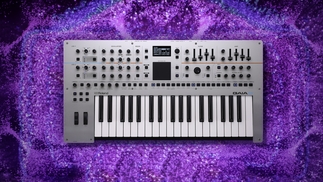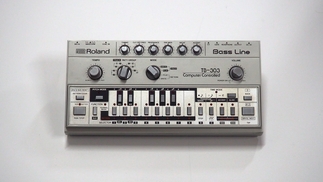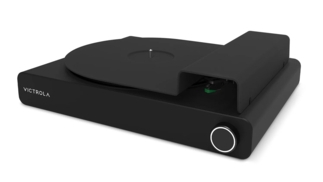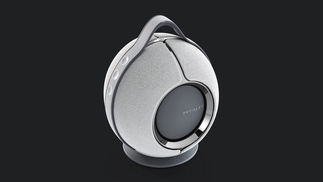Best portable bluetooth speakers for summer 2021

Believe it or not, summer is coming. Here are the best portable Bluetooth speakers to bring the party inside and out
Apparently, it’s almost summer, and despite the UK weather clearly being stuck in the past, that means it’s time to get ready for more picnics, BBQs, beers in the park and – fingers crossed – maybe even some COVID-safe festivals. And what summer situ can’t be improved with some glorious-sounding tunes? Exactly.
We’re rounding up your best portable Bluetooth speaker options, focusing on features, sound, build and battery life. With smart speakers taking over the home in recent years, we’ll also focus on how well they integrate with your home setup, if you’re looking for more than just a backpack-friendly device. Let’s dig in.
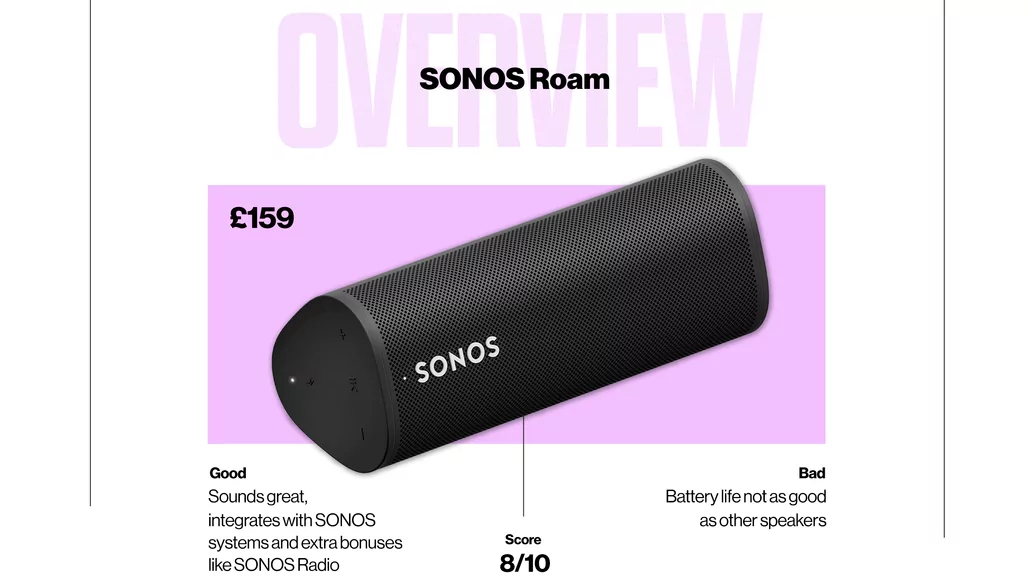
The SONOS Roam landed in 2021, promising a perfect integration with your existing SONOS system – if you had one – while also being the perfect portable music device, instantly and seamlessly swapping between WiFi and Bluetooth, depending on whether you were listening at home or on the move.
At £159, the most affordable way yet to get your hands on a SONOS speaker, the Roam brought with it not only connection magic but sonic expertise from Giles Martin, son-of-Beatles-producer-legend George, and the rest of the SONOS team. Throw in a bunch of out-n-about features like waterproof up to three feet for 30 minutes, drop-resistant and “impervious to dust’, it looked like SONOS were on to a winner. So how does it perform off the spec sheet and out in the real world?
The packaging is very slick – a simple brown cardboard box but with high-quality printing that screams environmentally conscious while still clinging on to SONOS’s high-end branding. Inside it’s a similar story: minimal. The Roam itself, a pouch to carry it in and a single USB A to USB-C cable for charging are all you get. No plug. You can’t just dive into your Bluetooth settings, connect and crack on – this is a SONOS speaker and as such needs the full app experience. Download it for your Mac/PC or mobile device and it’ll search and eventually find your Roam. Setup does take a little while if you’re new to the SONOS ecosystem.
"By buying into the Roam, you’re also buying into the SONOS ecosystem perks such as SONOS Radio"
Once you’re in though, the Roam sings with quality. The bass and low end is remarkably rounded and not at all boxy as you might expect from something this size. It rumbles nicely even at high volumes, resonating a warm, powerful bass, both soft and solid at the same time. While bass might be the go-to tester for portable speakers, SONOS also put a lot of time into the mids and highs, although there could be a bit more openness on the top end. There is an EQ but it’s only for bass and treble so there’s no mid-range tweaking. The Roam is also fairly loud – there are three different volume controls, within the music source (laptop, Spotify etc), the SONOS app and on the device which can be a bit annoying trying to figure out which one is too loud or too quiet.
The Roam also features TruePlay, a SONOS-specific feature that attempts to automatically EQ the sound depending on the walls and corners around it. It’s not particularly noticeable when it’s on or off or what it’s doing, but it’s a nice feature all the same.
Now for the downsides. While Roam’s Bluetooth and WiFi hot swapping is handy for seamless transitions from home to on-the-go (and it works well) there are some features that are WiFi-only, such as voice assistant (Siri and Google are supported), SONOS Radio and pairing multiple Roams or other speakers together. Also, when the Roam is connected to WiFi it stays on for a long time and doesn't go to sleep as quickly as others – great for quick connecting and communicating with other speakers in your home, bad for battery. Not the end of the world, it’s just recommended to always have it connected to a plug when it’s at home. Or you can get the wireless charging dock for ultimate pick-up-and-go for £44 extra. The Roam can be quite slow to charge too, over the included USB cable at least, so bear that in mind.
The Roam does have a lot going for it though. By buying into the Roam, you’re also buying into the SONOS ecosystem perks such as SONOS Radio with exclusive stations from FKA Twigs, The Chemical Brothers and more, Music Services that let you have all your streaming platforms in one place like Spotify, Apple Music, NTS Radio, Mixcloud, Bandcamp and TuneIn. You can also Search across multiple services at once, which is useful for bypassing annoying exclusives, assuming you’ve got the relevant subscriptions. And on the go, it works excellently, with long battery life and excellent sound. You really can’t ask for much more at this price point, with the SONOS extras a very attractive bonus.
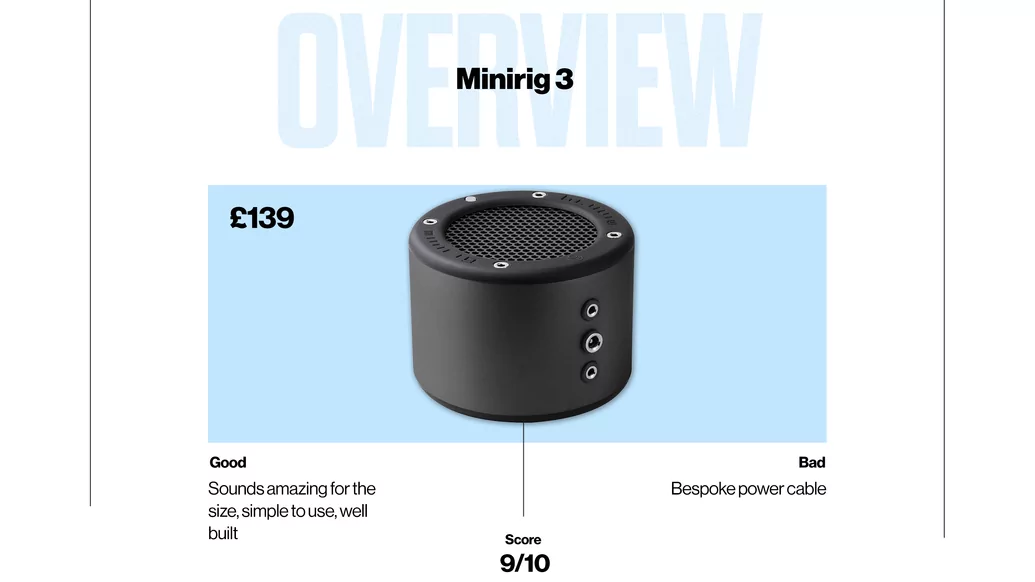
The humble Minirig has been quietly earning praise since the launch of the first version in 2015. Speakers have changed a lot in that time, with the term ‘smart’ being slapped on any mini music device with an attitude problem. Minirig has avoided the temptation to bundle more ‘cloud’ features into their remarkably small speaker, simply letting the sound speak for itself. And speak it does – this is the best sounding speaker we reviewed, once again. It is genuinely baffling how the Bristol-based boffins cram so much bass into such a small package, without sacrificing its integrity.
The whole sound is wide, crisp and loud without distorting, and outdoes its size many times over, managing to spread its sound way beyond its hockey-puck form. Every genre sound good – the mids and high are only sacrificed when you place it above your ear line so just make sure it’s down lower than your noggin and you’re sorted.
It features a single button for on and off – hold it to connect a device. The box is the same eco-friendly brown cardboard with swish printed text and includes a carry case, lanyard and bespoke charger that’s one-side USB A, one-side 9V DC. That’s a bit annoying as they’re not a common cable, so if you lose this one, you’ll need to order another directly from Minirig – you’re unlikely to have one lying around. There is also a 3.5mm input Aux, for hooking up any old school devices. The Minirig is focused on sounding great, being portable and being easy to use, and it’s hard to fault it for any of those things.
If you’re only interested in a speaker for on-the-go, and you don’t care about using it at home or as part of another setup, the Minirig has to be on your list. The app also adds a five-band EQ for personalised sound, as well as letting you tweak settings, chain multiple devices and much more
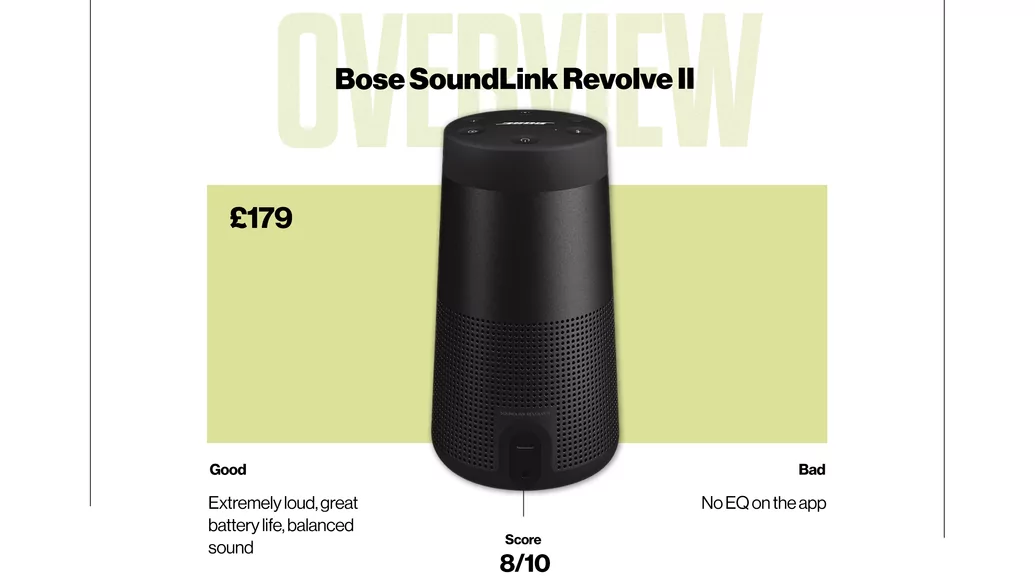
Bose’s reputation for high-quality sound emanating from well-built devices echoes around headphones, speakers, smart devices, soundbars, PA systems and beyond. They’ve been a go-to for quality audio for decades and have been able to cram exceptional sound into small devices long before portable or smart speakers came of age. They were also one of the first to master the art of audiophile sound on the go with their SoundLink Mini – still one of the best small speakers going despite it being discontinued by the audio giants.
The Revolve II, as the name suggests, is their second iteration of the series, and sits at the bottom of their portable speaker range, featuring the Revolve+ and the Bose Portable Smart Speaker, which goes all the way up to £329. At £179, the Revolve II is at the top end of what most would spend on a portable speaker, but bring a lot to the table for the price. It’s a sturdy affair, feeling solid and well built for chucking in backpacks, with rich bass and a crisp top end. It may lack a little mids compared to the SONOS and Minirig but it’s a well-balanced sound that translates well across genres. There is an app – Bose Connect – but it doesn't have an EQ sadly, to give those mids a slight boost.
The Revolve II plays heavily on its 360 audio capabilities, and while it does a good job of throwing the sound beyond its slender form, it’s not as ‘360’ such as Apple’s HomePod and HomePod Mini. But it’s not a home speaker, so we’ll cut it some slack.
"If you want it to be purely a portable and reliable speaker, it’ll last the whole festival and the journey home"
The best thing about this speaker? It’s loud. Extremely loud. In fact, we only ever ran it at around 50% and it was more than enough power for general listening. That handy perk feeds into the next best thing about this speaker: battery life. Because you ever have to crank it hard, the battery lasts a long time. In all of our testing it only went as low as 80% whereas the other speakers regularly ran to zero. Extremely impressive. One of the ways it archives this is that it’s very quick to go to sleep when not in use, so it clings onto precious battery life the moment you stop using it. It also lets you wake it just by connecting to it, so while it’s asleep, it’s never truly off. So you could place it somewhere tucked away and not have to manually turn it on and off – very handy and very smart. Even with its excellent battery life you can add a charging dock to sack off pesky Micro USB connection, for £25 extra.
Overall the Bose is a good option. It sounds good, it looks good, it goes extremely loud, and has great battery life. The app doesn’t offer much, unless you want to combine multiple Bose speakers, setting a timer to switch it off automatically, or update it. It doesn’t sound as good as the SONOS, and doesn’t have the extra SONOS Radio features, and costs £20 more. But it doesn't suffer from the inside-outside identity crisis of the Roam, so if you want it to be purely a portable and reliable speaker, it’ll last the whole festival and the journey home.
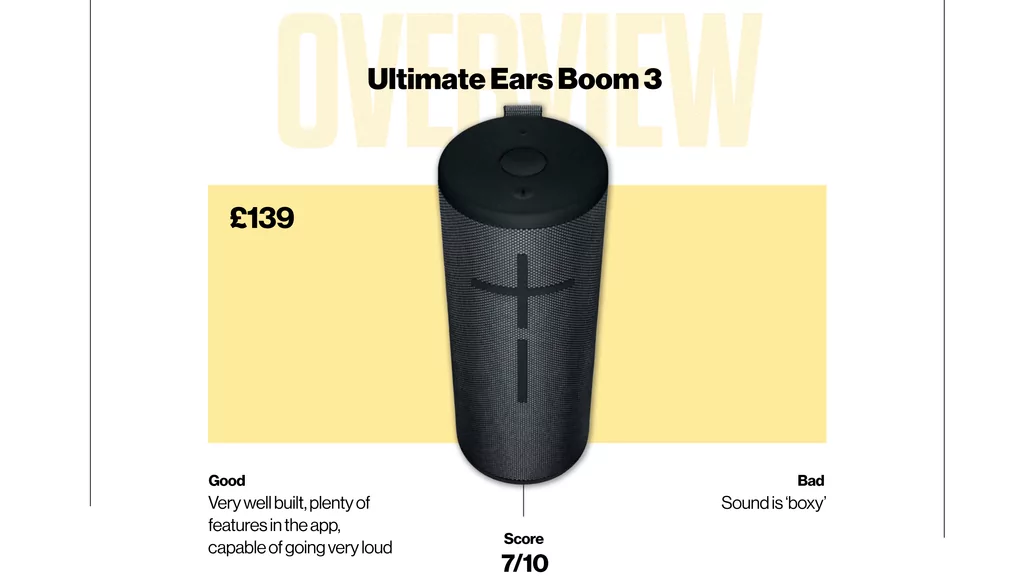
Ultimate Ears’ range of Bluetooth speakers has been super popular, with their chubby waterproof Wonderboom 2 a clear favourite among festival-goers and secret shower singers. The Boom 3 is a bigger, slender, more grown-up alternative, but still with the same portability and waterproofing features. It’s very much designed as a truly portable speaker that has no interest in doubling up or slotting into a home setting. With that in mind, it’s superbly built, feeling rugged and solid but still sleek, with oversized volume buttons and easy to use controls. It’s fairly weighty though still portable – build wise, the BOOM 3 would survive in the harshest of conditions.
On top, there’s one big button for power and for activating any playlists you’ve set up through the app. This is where you’ll also find the EQ with a few settings that can shape the sound depending on your surroundings or go rogue with five bands of custom tweaking. The app also lets you connect to Deezer, Apple Music or Amazon Music and you can launch a playlist directly from the device even when it’s switched off. The app also has the novelty capability of linking up to 150 different Ultimate Ears speakers together (or just two) for a huge wall of sound or to cater a very large party villa.
The sound of the Boom 3 is definitely the weakest of the bunch, sounding a lot boxier and restricted than the others. It’s heavy on the mids, with a low end that feels slightly restricted – it doesn’t vibrate like the others until it’s at very loud volumes. This is very much what you might have expected from a Bluetooth speaker a few years ago, but others seem to have leapfrogged the Boom in mini speaker tech. It’s not exactly bad though and can go very, very loud, but it won’t give you the 360 approach of the SONOS or Bose, and won’t give you the warmth either. With some EQ tweaks, it can definitely be improved from the standard-setting. But as we said, it’s not designed to be a home speaker and is very much built for the hectic, chuck-it-in-a-bag, camping, outdoor pursuits-type who are more interested in battery life and build quality than audiophile sound. If you don’t want to have to worry about your speaker being bashed around in the back of a four-by-four then it’s definitely a good option. It’s the best build quality of any of the speakers we tested.
One annoying trend that was present on previous versions too is the little indent on the charging port meaning not all micro USB cables will fit. It’s also awkward to even get the included cable to fit – there is an extra charging dock for £34. Overall, it’s hard to recommend it over the Roam at the same price unless build quality is an absolute priority.
The Minirig 3 is your best bet if portability comes first with its brilliant sound quality, solid build and no-frills operation. If you want something that doubles up as a home speaker, or can add to your existing home setup, the SONOS Roam and Bose Revolve II are both great options.


